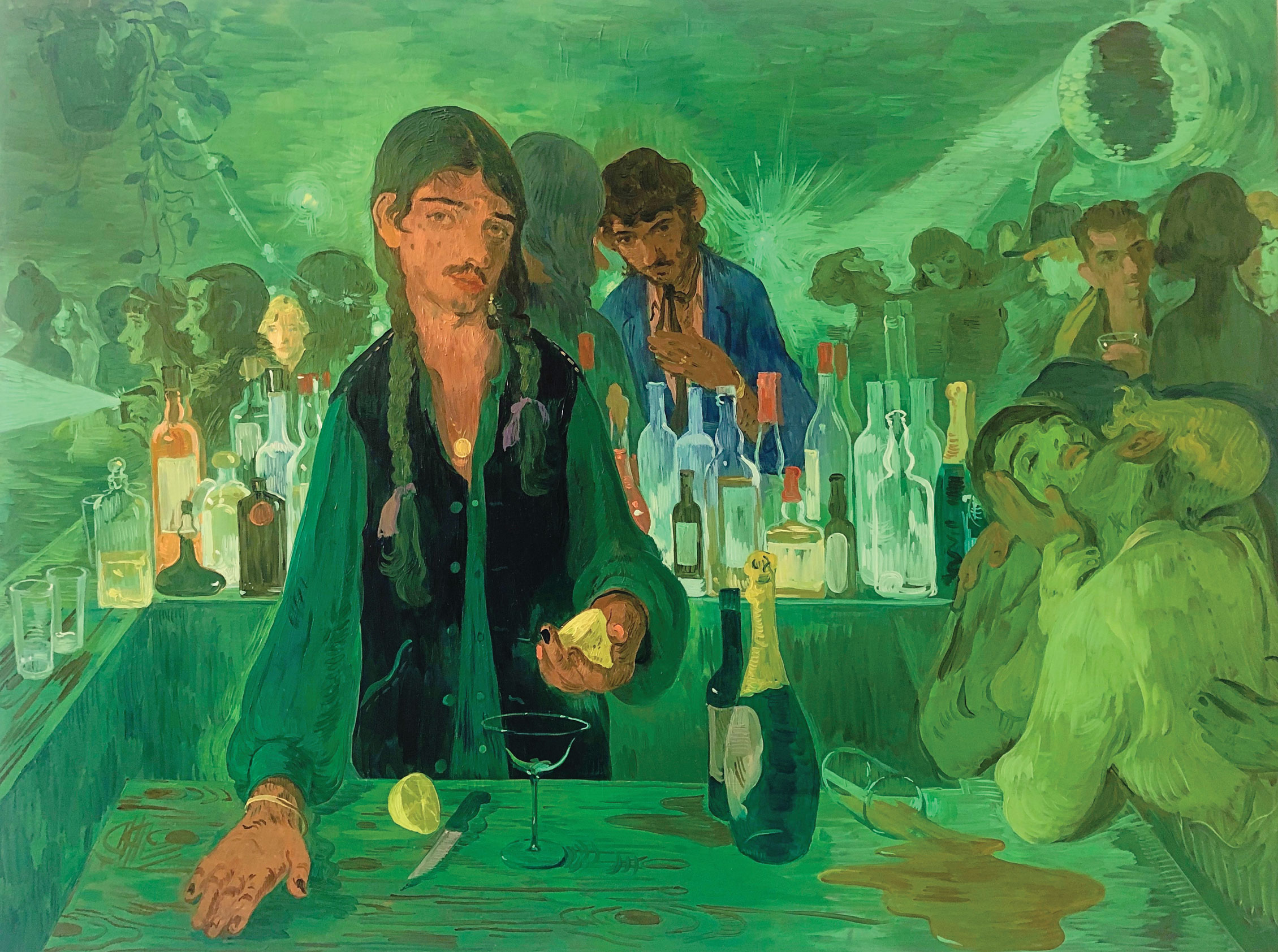
Fifty years ago, Jasper Johns, Robert Rauschenberg and Andy Warhol were hailed as artistic geniuses. They were also classified as sharing the same major mental disorder: homosexuality was regarded as an illness by the American Psychiatric Association until 1974. The state violently policed homosexual activity by raiding gay bars and monitoring any suspiciously pro-homosexual material sent through the postal system. Today, on the 50th Anniversary of the Stonewall Riots, which ignited the international LGBTQ+ Liberation Movement and overthrew the draconian political and medical systems of control, overt expressions of queer identity in art have become more commonplace.
Within this freedom of expression, a generation of American artists, growing up in the wake of the AIDS epidemic and enjoying more political freedom—relatively speaking—than their predecessors, are turning to the traditional realm of figurative painting to explore queer intimacy. From antiquity through the 19th century, the majority of bodies represented in paintings have been either of the ruling class or idealized forms representative of those who could afford to commission artworks. Here, we look to seven queer artists who utilize the aesthetic tool box of the European canon—which until recently would have excluded most of them due to their race or sex (closeted white male painters have traditionally enjoyed more artistic visibility)— to depict themselves and their loved ones, asserting the value of their experience through the form of figurative painting.
Just as this is the first generation to choose what aspects of the dominant social order, such as marriage and child-rearing, they want in their lives, so too are they choosing only what suits their needs from the art historical establishment. Unlike the artists active during the AIDS crisis like David Wojnarowicz, Felix Gonzalez-Torres, Marlene McCarty, and others, who were pushed to the margins of society, this generation of queer artists do not take overt political action or mourn the rampant loss of loved ones in their works. While all incorporate the figure, they do not quote the sculpted white male bodies of Paul Cadmus, Jared French or other painters that focused on idealized male nudes in the decades before Stonewall. Rather, many of the precedents for this generation are male stalwarts of the European canon—Thomas Gainsborough, Diego Velazquez, Édouard Manet, Édouard Vuillard and others.
These artists use a queer lens to deconstruct not only notions of sexuality enshrined in the canon and in today’s society, but also assumptions surrounding gender expression and identity, class and race, all of which are grafted onto the physical body. As certain individuals of the queer community—most notably, white gay men— enjoy greater acceptance in America, many other cohorts of this broad network still face demeaning and dangerous assumptions from the mainstream. Taken together, the works of these artists display a diverse and complex vision of queerness today, advocating for an expanded and inclusive visibility.
Salman Toor Salman Toor’s The Bar on East 13th pays homage to Manet’s 1882 A Bar at the Folies-Bergère, which depicts a stoic female bartender gazing directly at the viewer, the reflection of an obscured male patron in the mirror behind her the specter of the male gaze. Unlike the barmaid who is resigned to her objectification (some believe her to be a prostitute), the genderqueer bartender in Toor’s 2019 painting seems emboldened, demurely eyeing the attractive stranger in the mirror. Directly contrasting the rigid gender and sexual roles presented in Manet’s work, Toor’s painting presents queer people freely engaging in erotic and platonic reverie.
Born in Pakistan, Toor’s first visit to the National Gallery in London shook open a new world for him. “I was a Muslim outsider, so I had no idea what these Christian stories were, but because they were so gorgeous, I wanted to know everything about them—and I wanted to find a way to show my personal stories and the stories of my community like that.” Toor’s figures often quote the flamboyant dress of these painted figures—mainly brown queer men—in a fusion of contemporary and Orientalist garb, recasting the xenophobic fantasy that European artists applied to depictions of his home and culture.
As with the original Manet painting, Toor’s work foregrounds the view of the bartender through the mirror behind the bar. The perspectives of the subject and the viewer are unified through the mirror’s reflection, foregrounding the artist’s interest in double consciousness, the way in which minorities see themselves reflected through the gaze of dominant society. As a brown man living in a time of heightened xenophobia, the artist notes the suspicion with which some white Americans view him. Conversely, in Pakistan, the topic of the artist’s sexuality is never openly discussed in the art press. However, Toor finds levity in the code switching that is required to negotiate his identity. This quality of play and gliding between cultures animates Toor’s vibrant canvases.
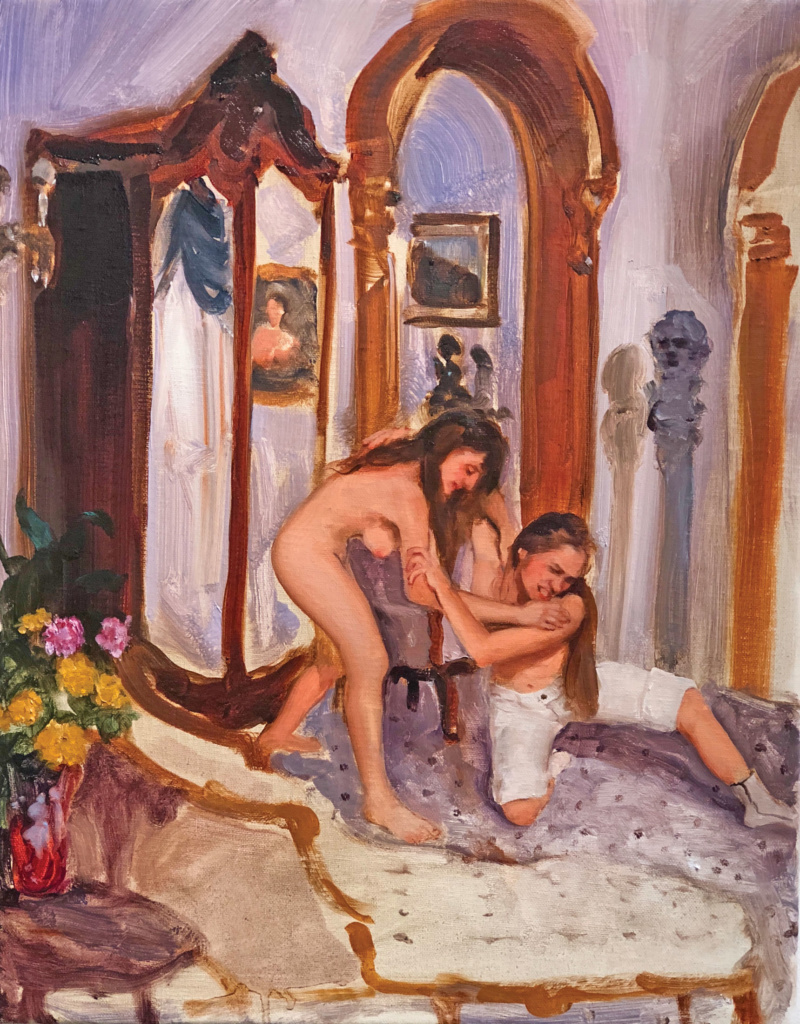
Jenna Gribbon Jenna Gribbon approaches the canon like a bull in a china shop, with her interest in the painterly and physical architecture of classic Eurocentric aesthetics immediately visible in Pollyanna Wrestlers (2018). In the painting, she places two female wrestlers in an antiquarian room, the traditional domain of women in repose. Painted to recall the 1960 Disney film Pollyanna, the room becomes a psychological space in which the artist revisits her own early encounters with cultural signifiers.
Gribbon’s female wrestlers—often based on her girlfriend or close friends—figure prominently in her practice. “These came from thinking about the trope of wrestlers, which are usually men. It seemed interesting to flip it and have them be female. There is also a tongue-in-cheek aspect, since they are playful and not actual wrestlers. It’s also erotic. There’s something funny about it. There’s something playful and maybe violent.” The complexities of Gribbon’s positioning of women is a direct rebuttal to the staid figures crafted for the male gaze by art historical heroes like Gainsborough and Jean-Antoine Watteau. “I was trying to find a new way to love those problematic paintings,” Gribbon offers. “There’s the issue of loving paintings of women, but then the problematic history of paintings of women.”
Part of Gribbon’s reclaiming of female beauty comes from her use of camp, an aesthetic strategy with deep roots in queer history. Delineated in Susan Sontag’s notorious 1964 “Notes on Camp,” the camp sensibility humorously blends elements of high and low culture to create an open aesthetic of exaggerated performance. Sontag noted that in the pre-Stonewall gay male community, this sensibility was the dominant social currency. Queer artists as diverse as Warhol, John Waters and RuPaul have defined practices around camp. “Camp takes risks and sometimes it falls on its face,” Gribbon says.
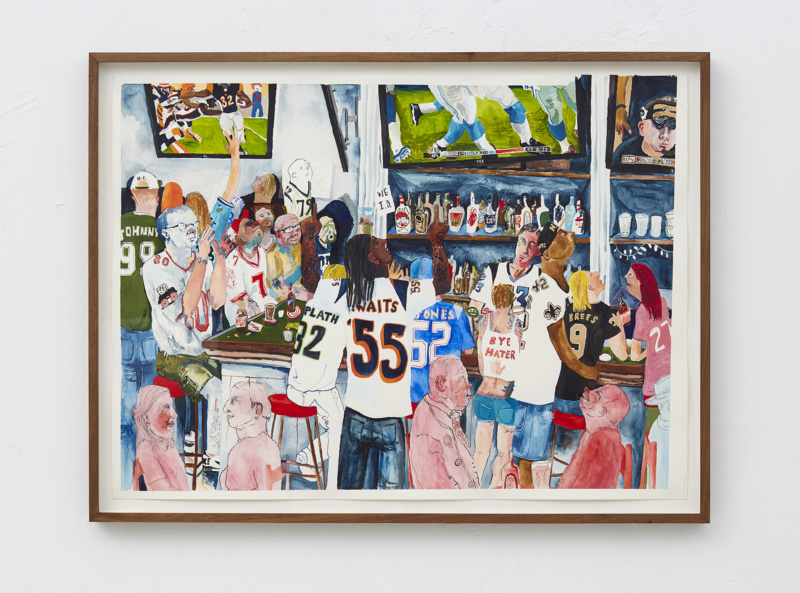
Celeste Dupuy-Spencer The title of Celeste Dupuy-Spencer’s It’s a Sports Bar But it Used to be a Gay Bar instantly identifies the queer figures at the lower edge of the work as the original inhabitants of a place now repurposed for a straight clientele. The gay ghosts and sports fans are thoroughly enjoying themselves in the same space, but in different ways—the former intently locking eyes, the latter cheering at screens.
Dupuy-Spencer’s 2016 painting of intimately-engaged queer couples foregrounds the development of empathy that occurs in queer individuals as a result of coming to terms with their inherent difference from established heteronormative narratives. “Confronting shame and trauma, knowing we are never going to fit in, queer people pick up a hypervigilance and awareness about what other people are feeling. That is empathy.” Holding the traumas of her queerness in one hand, Dupuy-Spencer simultaneously considers the privilege of her whiteness. “I keep my finger on the problem of whiteness, but also have a compassion for the people I grew up with. There is a huge fear around facing the history of our whiteness and the position that it gives us now, which is only possible if it holds other people back.” But rather than focus on the criticisms, Dupuy-Spencer sees painting as a space for potential reconciliation. “There needs to be a way to commune with those that are other than you,” she offers. “Painting is an act of healing. I believe that it’s possible to have done this hard work and the healing that comes to me also comes to the viewer.”
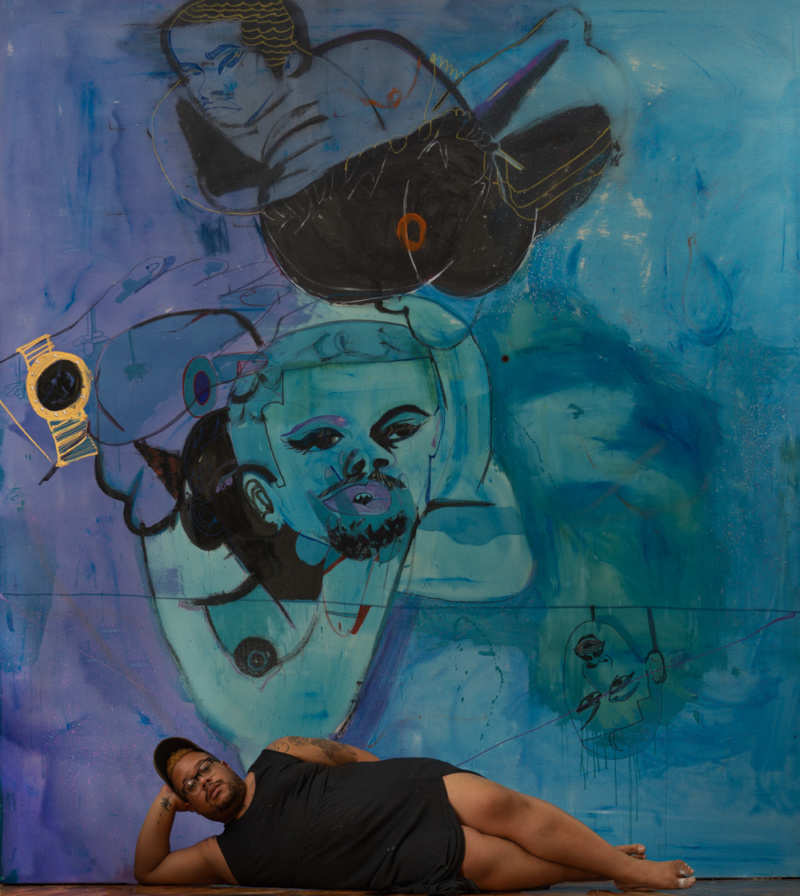
Jonathan Lyndon Chase In Men on Wet Bed (2018), Jonathan Lyndon Chase completely dissolves the distinction between two lovers’ bodies, depicting the figures as a gyrating vortex of erotic energy, riffing off Futurist and Cubist techniques to show various perspectives of the subject in motion. The field of the bed mirrors the ecstasy of the figures, as the room blooms into fields of fiery color, evoking the ways in which Francis Bacon’s figures morph within abstracted realms. The painting depicts a fulfilling sexual encounter between queer black men, a necessary representation of a marginalized community, which Chase explores in the majority of his oeuvre.
Interested in issues around bodies, pleasure and ideas of masculinity, Chase has developed a specific pictorial device, termed an “eight,” to address the unified male body. “There are infinity circles and loops that focus on pleasure points like the anus. The prostate is an interior world of pleasure that most people are denying themselves.” In Men on Wet Bed, the eights appear as mouths, nipples and anuses, swirling together in an erotic dance, a direct contrast to the ultimate male symbol of the phallus. While the phallus has become a symbol of differentiation between the sexes through dominance, “eights” seek to unify the sexes and unburden men from their phallocentric ideas of masculinity.
Chase’s works affirm the ability of the viewer to evolve and overcome the limiting structures of society. “I am trying to put out work that can be meditative, reflective and healing in many ways. I’m interested in Buddhism and self-mastery—thinking of how we can get closer to ourselves.”
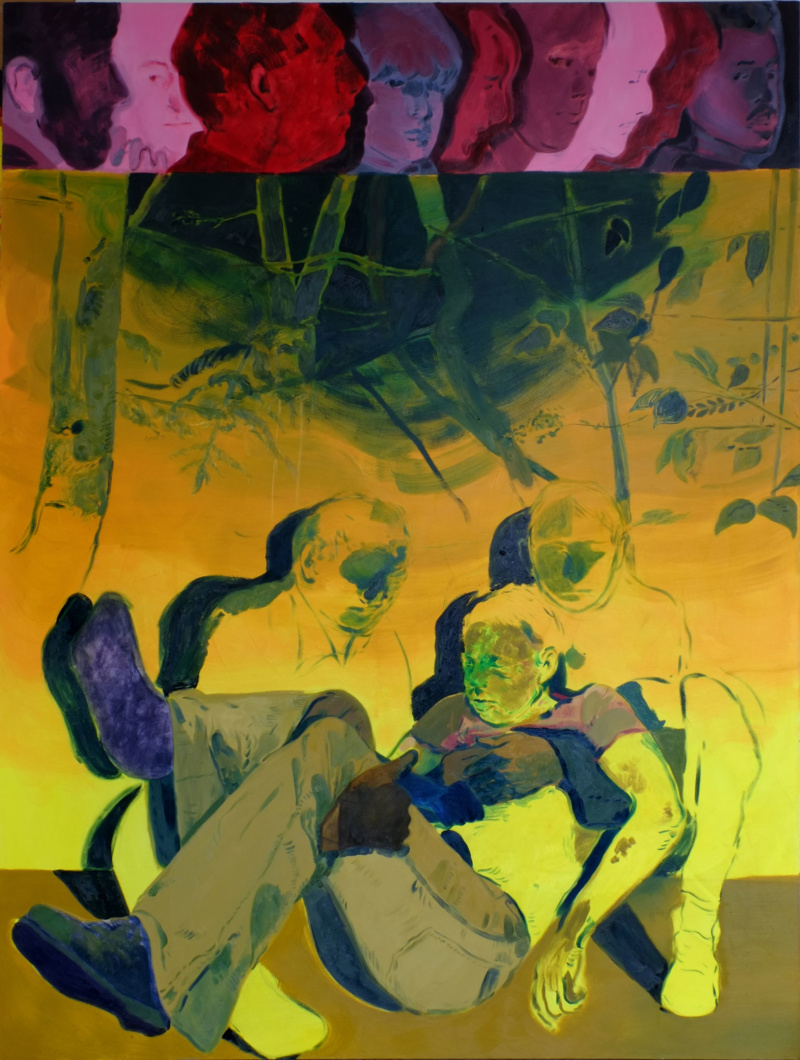
Anthony Cudahy Anthony Cudahy sourced the central image for his 2018 painting Everard (stage) from news footage of a 1977 fire that devastated the Everard Baths, a crucial meeting space for the New York queer community for much of the 20th century. “Nine people died in the fire, so in the top row are nine stand-in/spectators/angels. They are meant to point to this event being on a continuum, just as the stage aspect does,” he explains. The bathhouse was “a dangerous place to be in physically, but was a safe space socially. The windows were boarded up to add a layer of privacy and thus safety, so when the fire happened, people couldn’t get out.”
The three men on the stage—the physical embodiment of a support structure—serve as both the fundamental narrative of the painting and a symbol of the importance of queer safety networks, a theme Cudahy relates to sentinel theory, which claims that specific individuals in a species have evolved to remain awake in the evening hours to protect those who are sleeping. “People who are drawn to that act of trying to preserve a history that’s been covered up act like sentinels,” he says. “The past becomes a place that is not closed off.” By re-contextualizing past images to address the present, the artist speaks to the continuum of queer experience across generations. “I really like the word ‘tender’ because it has the romantic side to it and also the pain of something like a bruise,” he says, reflecting on the ways in which establishing intimacy requires the potentially dangerous act of exposing the innermost aspects of identity.
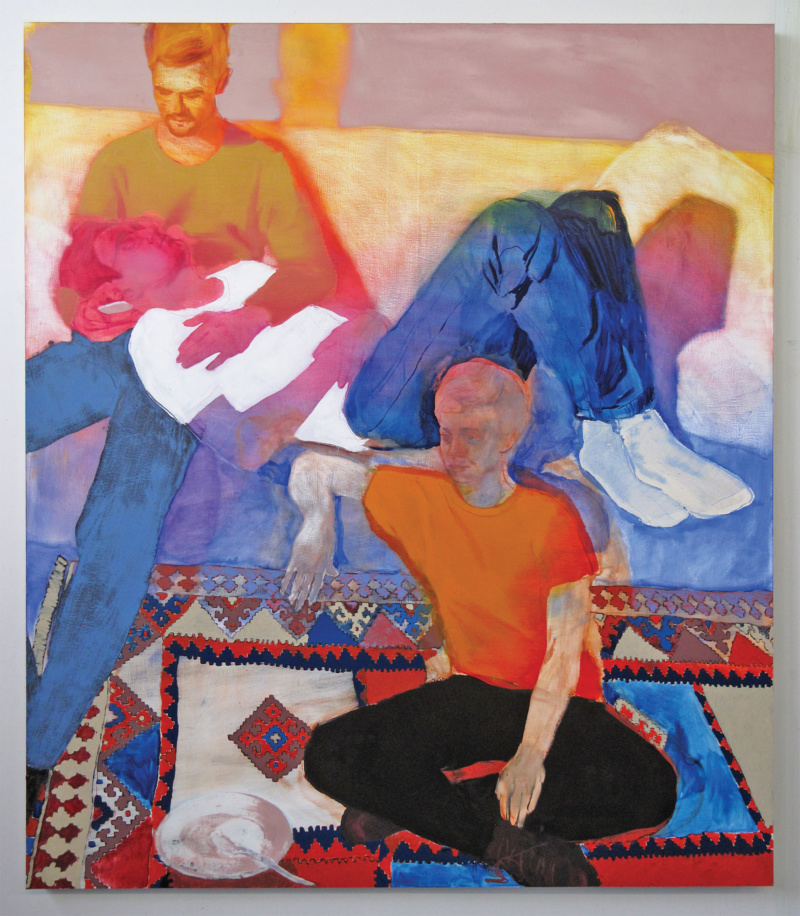
Doron Langberg The figures in Doron Langberg’s Louis, Tristan and Sarah are all in unisex clothing, obscuring the gender identity of the two without facial hair. The relationship between the figures is not clear. There is warmth and love, the exact terms of which are not defined. The 2017 painting contains enough details to suggest the figures are at ease in a safe space but remains open enough to allow for multiple readings of their relationships. The structure of the painted space is just as open—the sofa is a cloud bleeding into the figures, made even more opaque in contrast to the carpet, where the empty bowl reads more like an absence than an object with weight.
“Once you try to pinpoint exactly what makes the painting queer, it dissolves,” Langberg explains of his approach. “I love the idea that the form itself, the lens, is queer. It’s not that this brushstroke is gay and this one is not, but that the slippage is echoed in the way the paintings are made.” The very openness and antipathy to fixed narratives displayed in the paintings are also hallmarks of the artist’s life. “What conventions am I questioning and what am I accepting? It’s the same with constructing a painting. These paintings echo the way I see my life right now. Some aspects are finely honed, and the rest is very open.”
Langberg’s subjects span everything from portraits of friends and family to images of sex, though, he notes, many collectors shy away from the erotic paintings. “In art, depictions of straight desire can be about war, peace, God, anything you want,” he says. “But when a gay person does this, the work is immediately reduced to being only about sex.” While straight male desire can be used as a symbolic device, as in Eugène Delacroix’s Liberty Leading the People, or as a formal device for constructing abstract compositions as per Willem de Kooning and Pablo Picasso, the erotic images constructed from the gay male gaze can only be pornographic to straight eyes—a historical trend Langberg is specifically interested in challenging. “I want my experiences as someone from a more marginalized viewpoint to stand in for more than one thing. I want what I depict to be a nexus for the viewer’s experience as well, regardless of where they are coming from.”
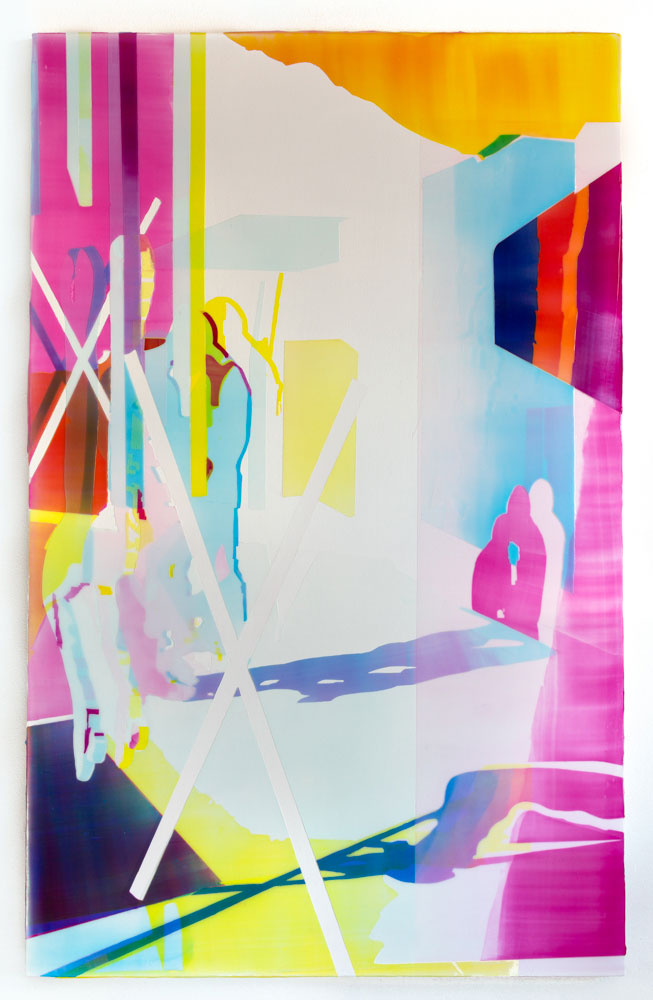
Zoe Walsh Planes of cyan, magenta and yellow float within an infinite white void, intersecting to create boldly-hued figures, architecture and spaces of pure abstraction. Two embracing figures repeat in different forms, hovering somewhere between reflection, shadow and the material. Zoe Walsh’s 2018 painting loop, pull, bleed, reveals no narrative. “It alludes to the painting process, camera movements and Photoshop layering effects,” Walsh explains. “I was thinking about the different forms of movement in each medium.”
“Pleasure is sacred to my work. It started with my interest in film spectatorship and a desire to create a space for a trans identification rooted in visual pleasure,” says Walsh of their interest in creating an aesthetic of trans-subjectivity untethered to the strictures of the gender binary. Taking cues from the ways in which Warhol used silk screen techniques to deconstruct glamour and celebrity, Walsh turns to highly constructed images of gender and sexuality, namely photographs of actors on the set of the 1984 gay porn Ramcharger. The erotic depictions of gay cowboys in the desert are processed through Sketchup and Photoshop, eventually appearing as genderless figures in the paintings. “These levels of transformation from the source material help me find ways to talk about a particular subjectivity that is about watching from a distance, imagining something that is not actually there.”
By removing the hyper-masculine signifiers of the photographs, Walsh reverses the societal mechanisms of gendering. While the genderless figures appear to exist outside of societal restraints, the images do not escape the specificity of their source material. There is no amount of reconfiguration that can fully erase the gender structures that serve as the architecture of the painting. “I want to talk about that space that is shifting and expanding, while also having some specificity based in queer source material. The works stop short at articulating a fixed subjectivity.”



